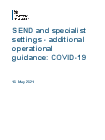Special schools and other specialist settings: coronavirus (COVID-19)

What all special schools and other specialist settings will need to do during the coronavirus (COVID-19) outbreak.
Documents
SEND and specialist settings – additional operational guidance: coronavirus (COVID-19)
HTML
Rapid asymptomatic testing in specialist settings
HTML
SEND and specialist settings – additional operational guidance: coronavirus (COVID-19)
PDF, 394KB, 47 pages
Details
This guidance applies to:
- special schools
- special post-16 institutions (SPIs)
- other specialist settings, such as hospital schools
Published 2 July 2020
Last updated 24 May 2021 + show all updates
-
We have converted the guidance to HTML to make it easier to read. We have not changed any of the guidance from the update on 10 May.
-
Guidance updated to reflect Step 3 of the Roadmap from 17 May 2021, including visits to Special residential settings (chapter 4), asymptomatic testing (chapter 11), funding (chapter 12), face coverings (System of Controls – Annex A) and confirmatory PCR tests (System of Controls – Annex A).
-
Updated ‘Rapid asymptomatic testing in specialist settings’ to reflect the introduction of nasal swab only tests at asymptomatic testing sites.
-
Updated to reflect changes in requirements for face coverings.
-
We have updated our guidance to reflect the DHSC announcement that a confirmatory PCR test is required following a positive LFD test result in England.
-
Guidance updated on advice for those who are clinically extremely vulnerable, LFD testing in post-16 settings, Test and Trace support payments.
-
Converted the additional operational guidance from PDF to HTML. This version clarifies previously published guidance on supporting those who are anxious about school attendance, clinically vulnerable and clinically extremely vulnerable, lateral flow device (LFD) testing in primary school and face coverings.
-
Reformatted ‘Rapid asymptomatic testing in specialist settings’ guidance as a HTML document – the guidance has not changed.
-
Updated ‘Rapid asymptomatic testing in specialist settings’ to include information about home testing for staff, twice-weekly testing of secondary aged pupils, and changes for on-site testing via asymptomatic test sites.
-
Added ‘Additional operational guidance for special schools, special post-16 institutions and alternative provision’. Removed ‘Guidance for special schools, specialist post-16 providers and alternative provision during the national lockdown’ and ‘Guidance for full opening: special schools and other specialist settings’.
-
Updated the guidance on rapid asymptomatic testing to include changes to daily contact testing advice, information on the rollout of testing to primary school staff and further guidance on the different approaches to testing.
-
‘Guidance for special schools, specialist post-16 providers and alternative provision during the national lockdown’ updated with information about attendance, recording and remote education expectations.
-
Published additional guidance for special schools, specialist post-16 providers, and alternative provision (including hospital schools) during the national lockdown.
-
Added ‘Mass asymptomatic testing in specialist settings’.
-
Updated section on pregnant employees.
-
Added information about tier 4 restrictions.
-
Updated the isolation period from 14 days to 10 days from the day after an individual tests positive for coronavirus (COVID-19).
-
Updated sections on assessment and accountability, and contingency planning for remote education.
-
Guidance updated to address the lifting of the national restrictions from 2 December 2020. Amendments to key policy areas have been made to reflect the local restriction tiers.
-
Updated guidance on SEND legislation (to reflect that temporary changes have now ceased), the system of controls, residential settings, attendance, workforce, safeguarding, wraparound provision and extra-curricular activity, curriculum expectations, behaviour expectations and contingency planning for remote education.
-
Added links to the ‘Education and childcare settings: New National Restrictions from 5 November 2020’.
-
Replaced references to “local lockdowns” with references to the local COVID alert levels.
-
Updated the section on managing confirmed cases of coronavirus (COVID-19).
-
Amended the information on risk assessments for those with an education, health and care plan.
-
Updated guidance to reflect the actions special schools and other specialist settings need to support full opening from the start of the autumn term. The main changes are listed at the start of the document.
-
First published.













Responses